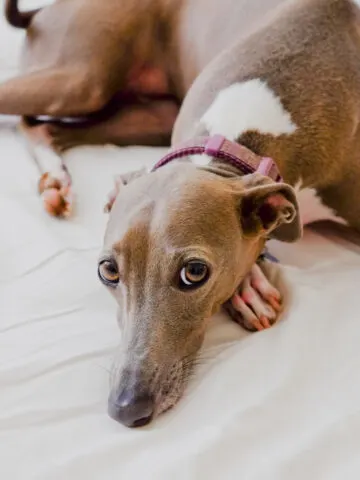Although the Italian Greyhound may look like the miniature version of its cousin, the Standard Greyhound, this little sighthound is in a league of its own.
Designated as its own breed, this small dog is loving, intelligent, and easy to maintain. With a “wash and wear” coat and diminutive size, the Italian Greyhound is a popular pet option for families worldwide.
If you suffer from pet allergies, the Italian Greyhound is considered a hypoallergenic breed.
This dog rarely sheds and does not produce the amount of dander other dog breeds do. The Italian Greyhound has easy grooming requirements and only needs monthly baths to keep it healthy.
Of course, it is crucial to understand what causes pet allergies.
While simply having a hypoallergenic dog may be enough to prevent severe allergy symptoms, this dog may still have proteins in its saliva and urine that can trigger an allergic reaction.
Plus, the Italian Greyhound will still shed, just far less than other dog breeds.
To prevent allergic reactions to even mild shedding, be sure to establish a cleaning routine to maintain an allergen-free living environment for you and your Italian Greyhound.
What Does Hypoallergenic Mean?
People beginning their search for a dog may frequently see the word “hypoallergenic” used when describing certain breeds.
The implication of this label suggests that the dog is 100% hypoallergenic and will not irritate people who have pet allergies.
The truth is that no dog is 100% hypoallergenic, and even so-called hypoallergenic breeds can still cause an allergic reaction in people.
Generally, the term hypoallergenic is given to dogs that shed very little. Most people have a pet allergy related to fur and dander, so light-shedding dogs are less likely to cause a reaction in people.
Of course, pet allergies can also come from pet saliva or urine, so even a designated hypoallergenic dog can still create allergens that cause allergy symptoms to worsen.
Do Italian Greyhounds Shed?
One of the qualities about this little dog that attracts so many people is the fact that the Italian Greyhound rarely sheds. The dog has a short, smooth coat that stays relatively intact throughout the year.
Of course, all dogs shed, but only a minimal amount is detected from this dog breed. Simply wipe down the dog with a soft cloth or slicker brush to remove dead or loose hairs to manage to shed.
How Do I Groom An Italian Greyhound?
Although this little dog has an incredibly smooth coat that rarely sheds, it is important to keep up with a routine grooming schedule for your Italian Greyhound.
The dog will require regular baths to keep its coat and skin clean and healthy.
At a minimum, bathe your Italian Greyhound once every six weeks. Because of the short fur and oily skin, washing your dog as much as once a week shouldn’t cause any significant drying or skin issues.
You’ll want to use a shampoo that best works with your dog and its activity level. If your dog is regularly outside, find a deep-cleaning shampoo.
If your dog is prone to dry skin, use a moisturizing shampoo with a soothing oatmeal blend.
Maintaining a healthy coat and moisturized skin will not only keep your Italian Greyhound healthy but will eliminate any possible fur or dander that can trigger an allergic reaction.
Can An Italian Greyhound Trigger An Allergic Reaction?
Calling a dog hypoallergenic can be misleading. Just because a dog is unlikely to cause an allergic reaction, it does not mean that an allergic reaction is impossible.
All dogs will have some oil, saliva, dander, or fur that could potentially irritate pet allergies in people.
While the Italian Greyhound is undoubtedly less likely than other dogs to trigger an allergic reaction, it is essential to understand that it is still possible.
People who suffer from pet allergies are allergic to certain proteins found in the dog’s saliva, urine, fur, skin, or dander.
Just because this non-shedding breed doesn’t produce allergy-causing fur and dander doesn’t mean that a person couldn’t be allergic to saliva or urine.
It is always best to fully understand your pet’s allergy and triggers before committing to a dog, even a hypoallergenic breed.
What Can I Do To Mitigate Pet Allergies?
If you suffer from pet allergies but still want to add a dog to your family, there are steps you can take to help minimize your symptoms.
The first step is to find a hypoallergenic dog because these breeds, like the Italian Greyhound, are less likely to cause an allergic reaction.
Secondly, routine home maintenance and cleaning can help prevent fur and dander build-up in your home. Some best practices to eliminate pet allergens in your home include:
- Vacuum Regularly – Even though you may own a hypoallergenic dog breed, there is still a chance that your dog will shed and produce dander. Vacuum your home regularly to eliminate any potential allergens that might cause an allergic reaction.
- Launder Fabrics – Dander and fur can become trapped in soft textiles and fabrics. Be sure to regularly clean couch cushions, pillows, rugs, and drapes that could potentially trap harmful allergens.
- Dust – Pet fur and dander can also land on hard surfaces. Be sure to regularly dust, at least once per week, to clear dander from hard surfaces like shelving, baseboards, and counters.
- Invest in Hepa – Air filters will help purify the air in your home, removing dust and dander. Invest in high-quality Hepa filters to trap the most amount of dander possible.
- Pet Free Zone – Allergies are possible, even with a hypoallergenic dog. Designate an area of your home, like the bedroom, that will remain a pet-free zone. This room will be a space where you can get relief from nagging allergies.
What Are Other Hypoallergenic Dog Breeds?
Remember that hypoallergenic dog breeds can still create an allergic reaction in people, especially if saliva or urine causes the reaction.
Adopting a hypoallergenic dog reduces the chance that you will have a reaction and is a great first step for allergy sufferers who want to own a dog.
The Italian Greyhound is a hypoallergenic breed, but several other hypoallergenic breeds may also be suitable companions. Some popular hypoallergenic dog breed options include:
- Poodle – The Poodle hardly sheds, making it an ideal choice for allergy sufferers. This dog breed comes in a variety of sizes ranging from a Toy Poodle to the Standard Poodle. Plus, there are several hybrid designer dogs mixed with Poodles that have the potential to be hypoallergenic.
- Bichon Frise – The soft, wooly coat on a Bichon Frise is very allergy-friendly. This small dog makes an excellent companion and rarely sheds.
- Afghan Hound – If you are considering a larger dog, the Afghan Hound may make an excellent choice. Although the Afghan Hound fur is incredibly long, it resembles human hair more closely than thick dog fur.
- Airedale Terrier – This brave, intelligent, and athletic terrier is perfect for people who suffer from pet allergies. The tight curls on the Airedale coat don’t shed a tremendous amount, reducing fur and dander in your home.
- American Hairless Terrier – If you want to eliminate fur and dander, consider the American Hairless Terrier. This medium-sized dog does not have any fur, making it a joy for allergy sufferers. Keep in mind that people who suffer from pet allergies may still react to this dog’s urine or saliva.
- Schnauzer – The Schnauzer makes a wonderful pet for allergy sufferers and comes in various sizes, from a small 10-pound companion to a male Giant Schnauzer that can top 100 pounds. The tightly curled coat on this dog rarely sheds, but it does require some intensive grooming routines to keep its coat healthy.
Related Questions
What should you feed an Italian Greyhound?
The Italian Greyhound has an extremely limited diet and must eat grain-free food for optimum health.
Give your dog the appropriate serving size according to the manufacturer’s instructions and your dog’s weight and activity level.
It is essential to give your dog a diet that is high in protein and fatty acids. Not only will these ingredients help keep your pet healthy, but they will help keep your dog’s coat looking great too.
Plenty of fatty acids and protein will add much-needed oils to your dog’s skin and coat. When your dog’s skin is well moisturized, it can help reduce the limited dander and hair this pet is capable of producing.
Are Italian Greyhounds high maintenance?
In general, this dog is considered very low maintenance. It has limited exercise requirements, and grooming is a breeze.
The short fur and relatively healthy skin can make grooming as simple as a 15-minute session once per week.
Some owners only need to “dust” their Italian Greyhound when they notice dander accumulate on the surface of the fur.
Our team is composed of pet care professionals, veterinarians, and pet owners. To date, we’ve conducted thousands of hours of research to publish the most accurate pet information.
Most of the writers on our site are vets with 10+ years of clinical experience, ranging from small practice, to equine practice, academia, and surgery. Our goal is to help every pet owner get the information they seek about their dear companions.



Leave a comment
You must be logged in to post a comment.